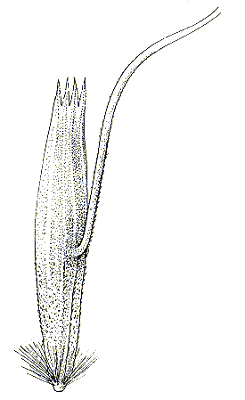Amphibromus macrorhinus S.W.L.Jacobs
& Lapinpuro. Telopea 2: 723 (1986).
Classification.
(GPWG 2001) : Subfamily Pooideae. Tribe Poeae.
Type of Basionym or
Protologue Information: Australia: Victoria: on the Wangaratta road, 6 mi
[10 km] from Whitfield, 1 Nov 1960, small tussocks beside road in open position
in flat farmland, T. B. Muir 1682 (HT: NSW; IT: AD-96734057,
MEL-100562).
Key references
(books and floras): [2002] D.Sharp & B.K.Simon, AusGrass, Grasses of
Australia, [2006] J.Jessop, G.R.M.Dashorst, F.M.James, Grasses of South
Australia (197), [2008] S.W.L.Jacobs, R.D.B.Walley & D.J.B.Wheeler, Grasses
of New South Wales (118), [2009] A.Wilson (ed.). Flora of Australia,
Vol 44A. Poaceae 2 (133), [1989] T.D.Stanley & E.Ross. Flora of
South East Queensland, Gramineae 3
(118).
Illustrations:
[2006] J.Jessop, G.R.M.Dashorst, F.M.James, Grasses of South Australia (197, fig. 145), [2008] S.W.L.Jacobs,
R.D.B.Whalley & D.J.B.Wheeler, Grasses of New South Wales, 4th edn
(118), [2009]. A.Wilson (ed.), Flora of Australia 44A: Poaceae 2
(135, Fig.20).
Derivation: Gk.
makros, large; rhis, nose. Lemma apex drawn out.
Habit.
Perennial. Culms erect, 50–100 cm tall, 1–2.5 mm diam., 2–4 -noded. Mid-culm
nodes glabrous. Leaf-sheaths smooth or scaberulous. Ligule an eciliate
membrane, 6–17 mm long, acute. Leaf-blades flat or involute, 15–30 cm long,
1.5–4 mm wide. Leaf-blade surface smooth to scabrous, indumented.
Inflorescence.
Inflorescence compound, a panicle. Panicle 20–40 cm long.
Spikelets.
Spikelets pedicelled. Fertile spikelets many flowered, with at least 2 fertile
florets (4–5), comprising 4–5 fertile floret(s), with a barren rachilla
extension or with diminished florets at the apex, oblong, laterally compressed,
10–17 mm long.
Glumes. Glumes
similar, thinner than fertile lemma. Lower glume lanceolate, membranous, much
thinner on margins, keeled, 1-keeled, 1–4 -nerved. Upper glume lanceolate,
4.2–7.5 mm long, membranous, keeled, 1-keeled, 5 -nerved. Upper glume surface
smooth or papillose.
Florets.
Fertile lemma 3.5–8 mm long, without keel, 7 -nerved. Lemma apex dentate,
awned, 1 -awned. Median (principal) awn dorsal, 10–19 mm long overall, with a
straight or slightly twisted column or with a twisted column. Column 3.5–6.8 mm
long. Lodicules present. Anthers 3. Grain 1.5–2.25 mm long.
Continental
Distribution: Australasia.
Australian
Distribution: Western Australia, South Australia, New South Wales,
Victoria, Tasmania.
South Australia:
Eyre Peninsula, Yorke Peninsula, Southern Lofty, South-eastern. New South
Wales: South-Western Slopes, South-Western Plains. Victoria: East
Gippsland, Eastern Highlands, Gippsland Plain, Grampians, Midlands, Riverina,
Wannon, Wimmera. Tasmania: Midlands.
Notes.
Similar to A. nervosus but distinguished by the awn which is inserted
lower down, and the more drawn-out and chartaceous lemma apex.
Endemic. In southern
Australia. Grows on floodplains and banks of inland and coastal rivers of
southern Australia. Flowers in response to rain or flooding, often Oct.-Dec.



